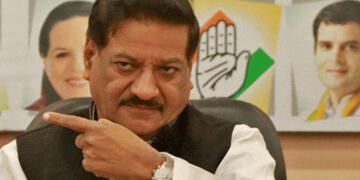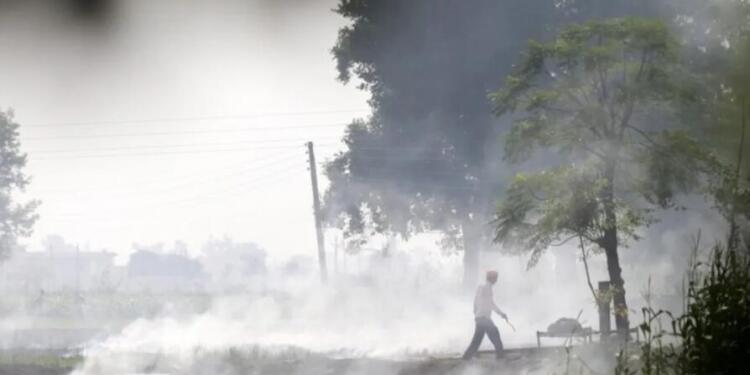Walking down the Charles Bridge in Prague holding hands of your partner isn’t the coolest thing on earth!!! You know what’s the coolest?? Wills Insignia between the lips, Louis Vuitton’s leather jacket down the arms and words expressing concern over environment and fauna in Deepawali.
The Hindu festival of Diwali for years has been standing accused in the media trials of being responsible for the high AQI (Air Quality Index) of the capital, Delhi. The coming of Diwali is an unwritten telegram for the politicians, media personnels, social media activists and the whole cabal to get ready with their cannons to fire at the Hindu festival.
Diwali along with happiness brings a series of bans imposed on firecrackers by the state government of the country and a plethora of propaganda to guilt trap the Hindu community.
In 2024, the day before and the day of Diwali saw poorer air quality in Delhi than in the past two years, which was highly emphasized by the media. Yet, interestingly, by the morning after Diwali, pollution levels were the lowest recorded post-Diwali since 2015, except for 2022, which the media either failed to report or intentionally overlooked. A similar trend was observed last year, when the AQI improved on the morning after Diwali, despite the festival’s celebrations.
This raises a critical question, should Diwali be blamed for Delhi’s increasing AQI? Or should more focus be placed on other significant contributors to the city’s poor air quality?
Stubble burning, which spikes in North India during this season, has been identified repeatedly by environmental researchers as a major cause of severe air pollution, alongside vehicle emissions and industrial activity.
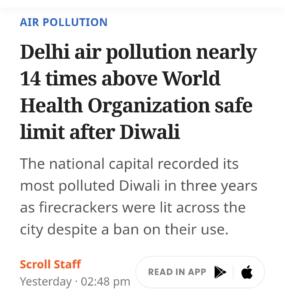
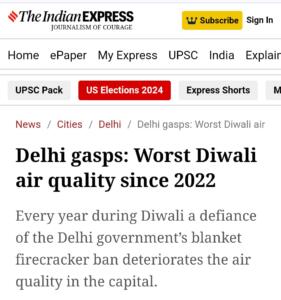
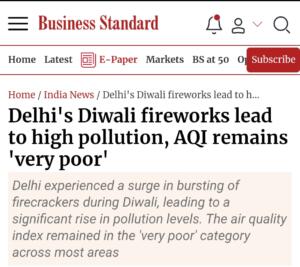
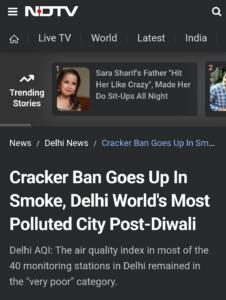
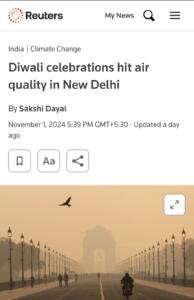
But we rarely see politicians, activities or media personnels pointing their fingers upon these factors for Delhi’s poor air quality. Should Hindus not see this selective outrage as part of a larger conspiracy against Hindu festivals???
Factors media courts often skip to mention while talking about Delhi’s poor health quality-
Stubble burning-
In 2022, a study by IIT Delhi, published in Atmospheric Pollution Research examined the primary sources of air pollution in New Delhi around Diwali where it came up with the conclusion of pointing out biomass that is stubble burning as the main cause for the depleting air health of Delhi.
The study, titled “Chemical speciation and source apportionment of ambient PM2.5 in New Delhi before, during, and after the Diwali fireworks”, showed that Diwali fireworks cause PM2.5 levels to spike with a 1100% increase in metal content, with fireworks contributing 95% of this.
However, this impact fades within 12 hours post-Diwali. (PM2.5 particles are tiny, about 30 times thinner than a human hair, making them easily inhalable and able to enter the bloodstream, posing significant health risks)
In the days following Diwali, biomass burning emissions—mainly from stubble burning and increased heating needs—cause PM2.5 levels to nearly double compared to pre-Diwali concentrations which the media always tried to hide. These emissions lead to a prolonged effect on air quality, especially through primary and secondary organic pollutants.
The study suggested categorically that stubble burning, rather than fireworks, is the primary cause of poor air quality in Delhi after Diwali. The Apex Court also termed firecrackers in Diwali as a temporary cause and held stubble burning the primary cause of higher AQI levels.
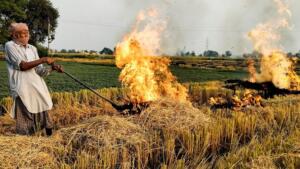
Stubble burning, even though it is the main cause of the deteriorating air health of Delhi, rarely gets any blame. While everyone was busy pointing fingers on diwali, stubble burning was silently getting its work done in impacting the AQI in the worst way possible.
On 31st of October, on the day of Diwali, Punjab reported 484 stubble-burning cases which is the highest number of cases in a single day in 2024. Data from the Punjab Pollution Control Board (PPCB) indicates that the total number of stubble-burning incidents in the state this year has risen and is now close to 3000. On the day of Diwali, Sangrur reported the highest number of stubble-burning cases among all districts in Punjab, with 89 incidents. Ferozepur followed with 65 cases, and Mansa reported 40 cases.
The contribution of stubble burning to PM2.5 levels rose sharply on Diwali day, increasing from 8.4% the day before to 27.61%. Diwali is often viewed as an opportunity to increase stubble burning, as it tends to go unnoticed, as every angry eye will turn towards the Diwali celebrations.
Climatic Conditions/ Thermal Inversion –
In 2024, Delhi experienced poorer air quality on the day before and the day of Diwali compared to the previous two years. However, by the morning after Diwali, pollution levels were the lowest recorded post-Diwali since 2015, with the exception of 2022.
The low pollution level after the day of diwali could be attributed to the absence of deep winter inversion conditions and the presence of reasonable wind speeds, which contributed to natural ventilation. This explains the significant role of climatic conditions in influencing the pollution rate in an area which people often ignore.
We all know that warm air is lighter than cold air, so naturally, warm air rises and disperses pollutants. As it rises, it cools down, and you’re familiar with the condensation process that leads to rain. However, during thermal inversion, this process is reversed. In conditions of thermal inversion, warm air, which normally moves upwards and cools, forms a layer above cooler air instead. This creates a kind of ‘virtual lid’ that traps the cooler air beneath it, preventing it from rising and mixing.
Since the heavier cool air gets trapped, it can’t rise. Remember, heavier things tend to stay lower rather than rise. This lack of mixing hinders the dispersion of pollutants, leading to poor air quality and sometimes smog.
Now, the question is: what conditions lead to thermal inversion and the formation of this ‘lid’ of warm air? Thermal inversion typically occurs during clear nights, in mountainous regions, and under high-pressure systems.
On clear nights, the ground cools quickly after sunset, and the air close to the ground cools more rapidly than the air above it, creating a layer of warm air above the cooler air. Similarly, in valleys, cool air sinks to the bottom while the warm air from the surrounding hills or mountains remains above, trapping pollutants below.
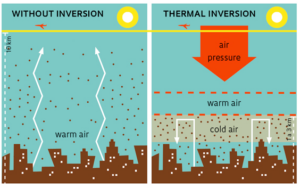
The media and the social media activists often ignore the role of climatic conditions or thermal inversion while writing hard pieces portraying Diwali as the villain.
Diwali usually comes in October or November which falls under the winter season. The presence of deep winter inversion conditions and absence of reasonable wind speeds, does not contribute to natural ventilation. Moreover the dramatic rise of stubble burning during Diwali contributes to the increase of AQI.
Green Revolution and Why Stubble Burning?
The “green revolution” of the late 1960s and 1970s did wonders for India and made the nation self-sufficient in food production. But along with the wonders it also introduced severe environmental challenges.

The use of high-yield crops and mechanized farming with combine harvesters led to the issue of sharp stubble left behind after harvests. To get rid of them, Farmers often burn this stubble to prepare fields quickly, contributing significantly to air pollution which we observe today in Delhi.
Ironically, Media while ignoring all these factors, cry horse upon diwali being celebrated. Politicians upon whose shoulders, the duty lies of controlling the air pollution of Diwali by taking measures from the very start of the year does nothing but curse, blame and impose ban upon firecrackers on diwali. Environment lovers whose tears start to come off by seeing the happy face of a 3 year old child enjoying diwali could not gain enough courage to point fingers at stubble burning.
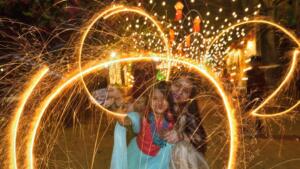
This shows that their concern for the environment was never a thing. The actual concern for the lobby is Hindus celebrating their festivals happily. The actual concern is them not being able to see a smile upon the face of Hindu kids .The actual concern is their Hinduphobia gaining life every time a Hindu festival approaches. Be it Holi, Diwali, Ramnavmi, Raksha Bandhan, Mahashivratri or any Hindu festival, the same lobby jumps every time with their agenda which is always the same to show their Hindu hatred/ Hinduphobia in full display.
Cancer can never be treated by gulping paracetamol !!! Likewise banning firecrackers and blaming Diwali will not tackle the root cause of pollution!!!




